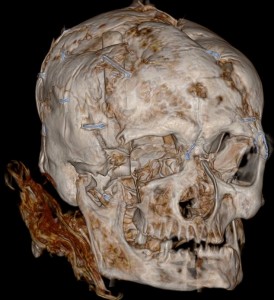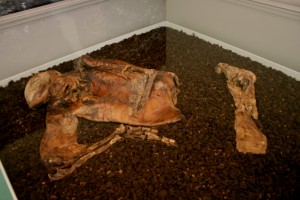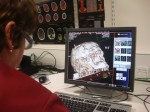 In August of 1958, peat cutters working a bog in Worsley Moss, Lancashire discovered the well-preserved head of a man. They reported it to the police, thinking that it was a recent death, possibly by violent crime. The police investigated the find spot, excavating extensively looking for additional body parts, but none were ever found. X-rays and chemical analysis suggested that the head was at least a hundred years old, so the Coroner returned an open verdict at the inquest and the Worsley head was put into storage at the Manchester Medical School pathology laboratory.
In August of 1958, peat cutters working a bog in Worsley Moss, Lancashire discovered the well-preserved head of a man. They reported it to the police, thinking that it was a recent death, possibly by violent crime. The police investigated the find spot, excavating extensively looking for additional body parts, but none were ever found. X-rays and chemical analysis suggested that the head was at least a hundred years old, so the Coroner returned an open verdict at the inquest and the Worsley head was put into storage at the Manchester Medical School pathology laboratory.
In August of 1984, another peat digger found a leg with a foot attached just 12 miles away at Lindow Moss. This time Rick Turner, county archaeologist for Cheshire, was alerted as well as the police and the next day Turner discovered the rest of the tanned body that would become known as Lindow Man. Lindow Man was the first ancient bog body knowingly discovered in Britain — such finds had been reported for hundreds of years in Ireland, Germany, the Netherlands and Denmark — so he became an instant celebrity.
In the wake of the interest generated by Lindow Man, Worsley Man’s head suddenly took on a whole new significance. In 1987, Manchester Museum archaeologists tracked down the head to give it a thorough forensic examination. They found a severe skull fracture, a wound behind the right ear, and the remains of a cord embedded into the flesh of his right cheek. There was also a cut at the second cervical vertebra where his head was cut off with a sharp implement. Worsley Man was between 20 to 30 years old when he died. Radiocarbon dating places his death at around 120 A.D.
 Lindow Man had similar “overkill” injuries: he was bludgeoned three times on the head, the remains of an animal sinew cord were found around his neck coupled with ligature marks and two broken vertebrae, and there is a cut above the ligature spot deep enough and perfectly positioned to sever the jugular vein. Archaeologists theorize that these injuries, any one of which could be fatal, were inflicted in a ritualistic manner, as a sacrifice to gods or punishment of social outcasts.
Lindow Man had similar “overkill” injuries: he was bludgeoned three times on the head, the remains of an animal sinew cord were found around his neck coupled with ligature marks and two broken vertebrae, and there is a cut above the ligature spot deep enough and perfectly positioned to sever the jugular vein. Archaeologists theorize that these injuries, any one of which could be fatal, were inflicted in a ritualistic manner, as a sacrifice to gods or punishment of social outcasts.
It’s not a universally accepted explanation, however. Some archaeologists think the injuries could have been inflicted during the course of a robbery. Pathologist Robert Connolly, who worked with the police when Lindow Man was first discovered and they were investigating the possibility that he was a contemporary crime victim, called the wounds evidence of “the brutal clubbing of a man wearing a necklace.”
 In 2011, a team of archaeologists decided to restudy Worsley Man’s skull using the latest and greatest technology. The radiology department of the newly built Manchester Children’s Hospital ran thorough CT scans on it.
In 2011, a team of archaeologists decided to restudy Worsley Man’s skull using the latest and greatest technology. The radiology department of the newly built Manchester Children’s Hospital ran thorough CT scans on it.
They confirmed that Worsley Man was definitely not a man wearing a necklace. There are deep wounds on his neck almost certainly caused by ligature. They’ve also confirmed that he was decapitated by a cutting instrument at the time of death, so he didn’t lose his head via peat cutter.
Fascinatimg article
Benjamin Raucher
Pete Cutter is innocent!